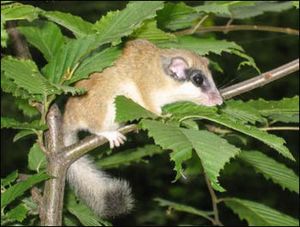Forest dormice facts for kids
Quick facts for kids Forest dormouseTemporal range: Middle Pleistocene - Recent
|
|
|---|---|
 |
|
| Dryomys nitedula | |
| Scientific classification | |
| Kingdom: | |
| Phylum: | |
| Class: | |
| Order: | |
| Family: | |
| Subfamily: | |
| Genus: |
Dryomys
Thomas, 1906
|
| Species | |
The forest dormice are a group of small, furry animals. They belong to the genus Dryomys. These tiny creatures are a type of dormouse. You can find them living across a large part of Eurasia. They usually live in forests or thick bushes.
These dormice are quite small. Their head and body are about 8 to 13 centimeters (3 to 5 inches) long. Their tails are also long, measuring 6 to 11 centimeters (2 to 4 inches). They are very light, weighing only about 18 to 36 grams (less than an ounce to about 1.2 ounces).
Life of a Forest Dormouse
Forest dormice are interesting animals. They are famous for their long sleep during colder months. This deep sleep is called hibernation. They often hibernate inside tree hollows or in underground burrows.
When they are awake, these dormice are mostly active at night. This means they are nocturnal. During the day, they might rest in low branches or shrubs. They spend a lot of their lives high up in trees.
What They Eat
Forest dormice are omnivorous. This means they eat both plants and animals. Their diet includes seeds, acorns, and plant buds. They also enjoy eating invertebrates, which are small creatures like insects. Sometimes, they even eat eggs and baby birds.
How They Have Babies
Forest dormice in warmer, southern areas have babies from March to December. Those in cooler, northern areas breed from May to August. A mother dormouse is pregnant for about 21 to 30 days. She usually gives birth to 2 to 5 young at a time.
Types of Forest Dormice
There are three main types, or species, of forest dormice:
- Woolly dormouse - Dryomys laniger
- Niethammer's dormouse - Dryomys niethammeri
- Forest dormouse - Dryomys nitedula

